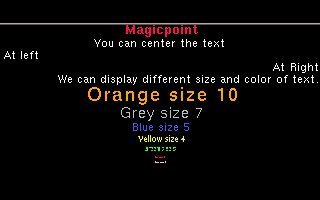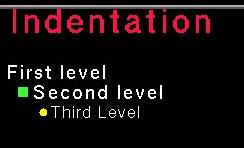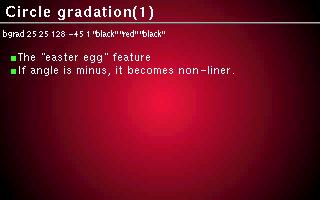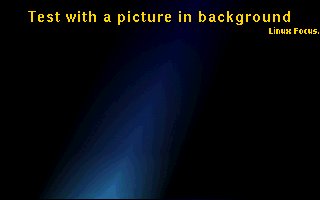| This document is available in: English Castellano Deutsch Francais Nederlands Russian Turkce |
![[Photo de l'auteur]](../../common/images/Charles-V.jpg)
by Charles VIDAL <charles_vidal(at)bigfoot.com> About the author: President of a gastronomic lug in Paris, He likes the GNU philosophy and Open Source, because they both allow people to share knowledge. He would like to find some time to play Saxophone. Translated to English by: Charles VIDAL <charles_vidal(at)bigfoot.com> Content: |
MagicPoint
Abstract:
This article describes the features of the free software MagicPoint.
It is one among the very few free presentation software for X-Window.
The presentation is described by a simple but powerful language.
|
Presentation software became popular a few years ago and have now been integrated into the office sotfware packages by default. Before that, in order to make a presentation using a free system, the old method of the retroprojection with the slides (using latex Slitex ) was used.
But with the retroprojection of the computer's screen, the presentation take another dimension and make the presentation look better. Magic Point is a presentation software working with every X11/Unix system.
It comes from the BSD world and is developed by a japanese team. Writing a Magicpoint presentation is made through a text file. We will study its syntax later on.
Use the library FreeType to get a better font rendering but one must be careful because Apple has a patent on the true type fonts.
Sample pictures generated by MagicPoint.The character % is a special character of the language. It should be placed at the beginning of lines in order to tell Magicpoint that the rest of these lines are commands of the language. If there are several commands after %, they must be comma separated. If a line doesn't begin with a % then it will be considered as the presentation text.
%%Means the rest of the line represents comments Usually, a MagicPoint document begins with:
%include "default.mgp" %pageThe command include includes a file ( for example default.mgp). The command page begins a new page . The next line will be the title of the slide and skips a blank line.
| Commands | |
| %page | begins a new page. |
| %size size | sets size of fonts . |
| %fore "color" | color of foreground |
| %back "color" | color of background. |
| %left | Left justify. |
| %leftfill | Left justify, with folding of long lines. |
| %center | centering |
| %right | Right justify. |
| %cont | Draw without line break |
| %pause | Stop drawing until forward key or button is pressed. |
%include "default.mgp" %%%%%%%%%%%%%%%%%%%%%%%%%%%%%%%%%%%%%%%%%%%%%%%%%%%%%%%%%%%%%%%%%%%%%%% %page %fore "red", size 6 %center Magicpoint This will be centered %left This will appear left justified %right and this right justified Text can be shown with any size or color. %CENTER %SIZE 10,FORE "orange" Orange size 10 %SIZE 7,FORE "gray" Grey size 7 %SIZE 5,FORE "blue" Blue size 5 %SIZE 4,FORE "yellow" Yellow size 4 %SIZE 3,FORE "green" Green size 3 %SIZE 2,FORE "red" Red size 2 %SIZE 1,FORE "pink" Pink size 1


example :
%tab 1 size 5, vgap 40, prefix " ", icon box "green" 50



You can show a picture in the background with the command bimage .Syntax:
%bimage "imagefile" [ <screensize> ]Specifies the name of a background image file
<screensize> :: auto resizing. specify the original screen size with WIDTHxHEIGHT. unless screensize is the same size of the physical display, zoomrate is calculated automagically.
Where screensize is expressed as WIDTHxHEIGTH.
%page %nodefault %size 7, font "thick", fore "gold", bimage "bg-black-brilliant.jpg" 1024x768 %center, size 4 %size 7 Test with a background image %cont, size 7 %right %size 4 Linux Focus.

Magic Point can also display the result of a shell command like the version of your Linux kernel for instance. In order to do so, use the following syntax:
%filter "command" text to pipe to the standard input of the command .... %endfilterTo display the version of your linux kernel, type the command:
%filter "cat /proc/version" %endfilterTo better understand the syntax try:
%filter "rev" This is a test %endfilterThis will display the following string:
%system "xeyes -geometry %50x20+25+60"
You can find all the documentation about the syntax in a file called SYNTAX in magicpoint tarball.
| -b color | Specify background color |
| -d | Demo mode - go through the presentation |
| -g geometry | Set window geometry |
| -h | Display this help message |
| -n | Disables control key input from tty |
| -o | Do not override the window manager |
| -p page | Start at the specified page |
| -q | Do not beep on errors |
| -t timeslot | Enable presentation timer |
| -v | Show version number and quit |
| -w dir | Specify a working directory |
| -x engine | Disable specified rendering engine |
| -B | Ignore background image |
| -C | Use private colormap |
| -D | Generate html pages for the presentation |
| -F mode,effect,value | Use forwarding caches |
| -G | Page guide is on |
| -O | Obey to the window manager |
| -Q quality | Set background image quality(0-100) |
| -R | Do not perform automatic reload |
| -S | Do not process directives that fork process |
| -T timestampfile | Update timestampfile on page refresh |
| -V | Be verbose |
| -X gsdevice | ghostscript device to use |
If you want to put your presentation on the internet, the authors of Magicpoint have had the good
idea to add an option to make things easy:
mpg -D output_directory
mgp -D the directory where the html and pictures will be created.
You have to install xwintoppm; you can find it in the directory contrib of the tarball,
and put it in your PATH (if you do a make install, it will be in your PATH).
The program will display each screen and dump them into files and create html pages. Contributors have made some conversion programs from the file format mgp to other formats like Postscript ( mgp2ps ), then you can have a paper presentation to give to the public. Example of pictures generated by Magicpoint in html. .
In the directory contrib, you can find some perl programs:
|
|
Webpages maintained by the LinuxFocus Editor team
© Charles VIDAL, FDL LinuxFocus.org |
Translation information:
|
2002-11-17, generated by lfparser version 2.34